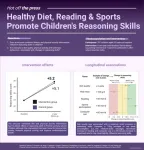(Press-News.org)
Earth’s rapidly changing climate is taking an increasingly heavy toll on landscapes around the world in the form of floods, rising sea levels, extreme weather, drought and wildfire.
Also at growing risk are the values of property where these hazards are projected to worsen, according to a new study by University of Utah scholars. The research team, led by biology professor William Anderegg, attempted, for the first time, to quantify the value of U.S. property at risk in forested areas exposed to increased wildfire and tree mortality associated with climate stresses and beetle infestation.
“As a society, we have this tremendous capacity to deal with and minimize, adapt to and mitigate risk,” said Anderegg, who heads the university’s Wilkes Center for Climate Science & Policy. “We have insurance policies, we have seat belts in cars and airbags. All of these are to mitigate the risk of getting in a car accident or having a fire burn down your house. But fundamentally, all these tools to mitigate risk are predicated on knowing what the risks are and capturing how those risks might change.”
A stark message from Maui
Climate change is a “game changer,” according to Anderegg, because it promises to elevate threats, yet we don’t know exactly where, when or by how much.
“This is a really clear case of where we need cutting-edge science and tools to tell us what are the risks and how are they possibly or likely to change this century due to climate change,” said Anderegg, who studies forest ecology. “Climate change is going to drive wildfire and disturbance risks up and is already driving them up. Insurers leaving states like California really underscores that.”
To help identify climate-related risks to property values, Anderegg teamed with faculty from the College of Social and Behavioral Sciences—geographer Tim Collins and sociologist Sara Grineski—and others outside Utah. Published Aug. 17 in the journal Environmental Research Letters, their study found more and more U.S. property will be exposed as climate change effects proliferate on forests.
“We find that property values exposed to these climate-sensitive disturbances increase sharply in future climate scenarios, particularly in existing high-risk regions of the western U.S.,” the study determined, “and that novel exposure risks emerge in some currently lower-risk regions, such as the southeast and Great Lakes regions.”
And[1] as if to drive that point home, the tropical Hawaiian Islands last week were the scene of the nation’s deadliest wildfire in a century after flames rampaged across Maui, destroying an entire city and leaving 96 dead in a toll that will certainly grow.
Most of the affected real estate is in the Southwest and California, where soaring values of private property near publicly owned woodlands are colliding with declining forest health and escalating fire risks.
The study deliberately avoided identifying specific areas at risk, but even a casual glance at Western real estate gives an idea of where the trouble spots are. Northern Utah’s more valuable residential property happens to be located in scenic locales, such as Emigration Canyon and Summit Park, that face severe wildfire risks.
The study examined three different phenomena that impact property values: wildfire; tree mortality from drought and other climate stresses; and tree mortality from insect infestation.
Tale of two climate crisis responses
The study projected what may happen during two 30-year windows, mid-21st century and end of the century, under opposing scenarios. The team found carbon emission-reduction strategies, if implemented effectively, could substantially dampen exposure.
“We looked at two separate climate scenarios, one in which we don't really do anything [to reduce emissions driving warming]—it's just business as usual, and things get more dramatically worse—and one in which we implement mitigation more aggressively,” said Collins, who co-directs the University of Utah’s Center for Natural and Technological Hazards with Grineski. “What the results show is that under a scenario in which we actually try to mitigate emissions in a way that reduces impacts of climate change, you see substantially less property value at risk in the future.”
Looking at just privately owned lots 1 acre in size or larger, about $4 billion (in 2017 dollars) in property is currently exposed per year to wildfire in the contiguous United States, according to the study.
That volume is projected to grow to $22 and $45 billion, by 2049 and 2099, respectively, under the do-nothing scenario. The study found, however, the value of exposed property tops out at about $11 billion under the scenario in which aggressive climate action is undertaken.
Wooded areas can be desirable places to live, but if the trees die or burn, such properties lose their appeal and their market value will erode accordingly.
“What's interesting is that people are drawn to those environments because of the amenities associated with forest resources,” Collins said. “This is where you're seeing the high value of these lands, like California—areas that are identified as wildland-urban interface—are some of the fastest growing landscapes in terms of residential development.”
The findings are conservative since they don’t consider anticipated growth in these at-risk landscapes.
“Under climate change, in the hot arid West, many people, as temperatures rise, are going to be increasingly drawn to these mountainous environments,” Collins said. “We actually just hold constant current levels of development, and we look at what is the effect of climate change and increased forest disturbance in terms of placing current property values at risk in the future. It doesn't even take into account the fact that more and more people are being drawn to these forest landscapes because of the amenities.”
The project was funded by grants from the David and Lucille Packard Foundation and the National Science Foundation. Collaborators included Christophe Nolte of Boston University and Sarah Nicholls of Swansea University in Wales.
END
Without aggressive climate action, U.S. property values will take a hit from escalating wildfire risk and tree mortality, study finds
2023-08-17
ELSE PRESS RELEASES FROM THIS DATE:
Bigger and better quantum computers possible with new ion trap, dubbed the Enchilada
2023-08-17
ALBUQUERQUE, N.M. — Sandia National Laboratories has produced its first lot of a new world-class ion trap, a central component for certain quantum computers. The new device, dubbed the Enchilada Trap, enables scientists to build more powerful machines to advance the experimental but potentially revolutionary field of quantum computing.
In addition to traps operated at Sandia, several traps will be used at Duke University for performing quantum algorithms. Duke and Sandia are research partners through the Quantum Systems Accelerator, one of five U.S. National Quantum Information Science Research Centers funded by the Department of Energy’s ...
Is data justice the key to climate justice?
2023-08-17
Bias in the collection of data on which Artificial Intelligence (AI) computer programmes depend can limit the usefulness of this rapidly growing tool for climate scientists predicting future scenarios and guiding global action, according to a new paper by researchers at the University of Cambridge published in Nature’s npj |Climate Action series.
AI computer programmes used for climate science are trained to trawl through complex datasets looking for patterns and insightful information. However, missing information from certain locations on the planet, time periods or societal dynamics create “holes” ...
AI model developed by Brigham researchers could help screen for heart defect
2023-08-17
The AI model was more efficient at detecting signatures of atrial septal defect (ASD) in electrocardiograms (ECG) than traditional methods.
Investigators from Brigham and Women’s Hospital, a founding member of the Mass General Brigham healthcare system, and Keio University in Japan have developed a deep learning artificial intelligence model to screen electrocardiogram (ECG) for signs of atrial septal defects (ASD). This condition can cause heart failure and is underreported due to a lack of symptoms before irreversible complications arise. Their results are published in eClinicalMedicine.
"If we can deploy our model on a population-level ECG screening, ...
Child Development Journal Q&A: How do youth view gang violence is shaping their communities?
2023-08-17
How do children and adolescents evaluate and reason about acts of physical violence in the context of chronic violence that impacts their communities? Previous studies have used situations that correspond with a single act of interpersonal harm void of broader conditions of violence shaping the context in question. A new study released in Child Development examined how youth exposed to gangs known as maras (e.g., MS 13) in Honduras morally deliberate about conditions of gang violence compared with youth not exposed to gangs in Nicaragua, where there are very few maras ...
Can children recognize sick faces?
2023-08-17
According to the World Health Organization, globally, infectious disease is a leading cause of death among children. Furthermore, children are more likely than adults to contract infectious illnesses. However, there’s a gap in research measuring children’s responses to sick faces. It is important to understand how children’s ability to recognize and avoid sickness emerges and develops to help improve children’s health and public health more broadly. Previous research has only reported that adults can use faces to recognize if someone is sick and make judgments about whether to approach or avoid them.
Researchers from the University ...
Lorazepam treatment may be linked to worse outcomes for pancreatic cancer patients
2023-08-17
PHILADELPHIA – Patients with pancreatic cancer who took the benzodiazepine lorazepam (Ativan), commonly prescribed to treat anxiety during cancer treatment, had a shorter progression-free survival than patients who did not, according to results published in Clinical Cancer Research, a journal of the American Association for Cancer Research (AACR).
In contrast, patients who took the benzodiazepine alprazolam (Xanax) had a significantly longer progression-free survival than patients who did not.
Benzodiazepines are a class of drugs that suppress the activity of the central nervous system, which can relieve ...
A healthy diet, reading, and doing sports promote reasoning skills in children
2023-08-17
Reasoning skills are crucial skills in learning, academic performance, and everyday problem-solving. According to a recent study conducted at the University of Eastern Finland, improved overall diet quality and reduced consumption of red meat, as well as increased time spent in reading and organised sports enhanced reasoning skills among children over the first two school years.
“Children with healthier eating habits showed greater cognitive development than other children. Specifically, better overall diet quality, ...
Heredity and environment account for people’s love of nature
2023-08-17
Humans have a positive view of nature. But is this due to an approach we have learned while growing up, or is it something we are born with? The answer is ‘Both’, according to researchers at the University of Gothenburg and the Swedish University of Agricultural Sciences.
Our love of nature is highly individual and should influence how we plan our cities, say the researchers.
It is well known that nature has a positive effect on people. In cities in particular, studies have shown that trees and other greenery contribute to people’s wellbeing. However, experts do not agree on the reasons behind this phenomenon, known ...
Are you breaking your body clock?
2023-08-17
Researchers are using mathematical models to better understand the effects of disruptions like daylight savings time, working night shifts, jet lag or even late-night phone scrolling on the body’s circadian rhythms.
The University of Waterloo and the University of Oxford researchers have developed a new model to help scientists better understand the resilience of the brain’s master clock: the cluster of neurons in the brain that coordinates the body’s other internal rhythms. They also hope to suggest ...
HKUMed & CityU researchers jointly generate human neural stem cells with powerful therapeutic potential for the treatment of spinal cord injury, paving the way for new therapeutic opportunities
2023-08-17
A joint research team from LKS Faculty of Medicine, the University of Hong Kong (HKUMed) and City University of Hong Kong (CityU) has generated human neural stem cells with powerful therapeutic potential for the treatment of spinal cord injury that paves the way for new therapeutic opportunities. The new findings are now published in the leading multidisciplinary science journal, Advanced Science [link to publication].
Background
Traumatic spinal cord injury (SCI) commonly caused by a car accident, fall, or sport-related accident results in the progressive loss of neurons involved in motor and sensory functions at and around ...






